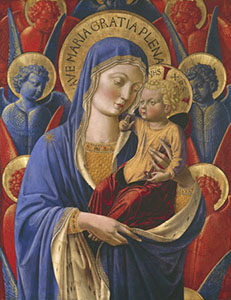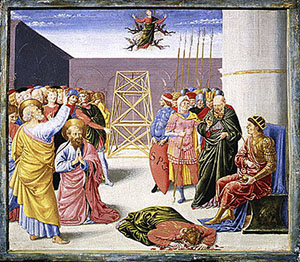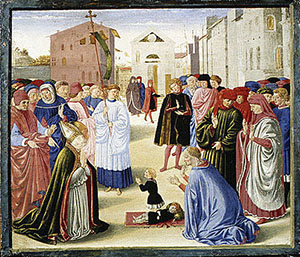
Madonna and Child, Institute of Arts, Detroit.

The Fall of Simon Magus, predella of the Alessandri altarpiece, Metropolitan Museum of Art, New York.

Saint Zanobius Resuscitating a Child, predella of the Alessandri altarpiece, Metropolitan Museum of Art, New York.
Piero il Gottoso (the Gouty), who was responsible for furnishing the new palace on Via Larga, decided to engage Benozzo to paint the private chapel, trusting in the artist’s extraordinary talent to depict a vivid variety of subjects with an equally realistic rendering of portraits, clothing and landscapes. In 1459, therefore, he created the frescoes of the world-famous Procession of the Magi, in which the sumptuous procession of the three kings is illustrated against a backdrop of richly detailed landscapes with a fairytale air, seeming to increase the size of the small chapel. In reality, this Evangelical episode was merely a pretext for the commissioners’ desire to celebrate the power and wealth of the Medici family, effectively emphasised by the opulence of the robes, in a setting which undoubtedly served a dual purpose as a place of worship and a venue for small private audiences.
This commission, still considered Benozzo’s greatest masterpiece, demonstrates the artist’s rise to the status of one of the powerful Medici family’s most trusted painters.
Although, due to the strictly private nature of the little chapel, these frescoes could not be seen by many of his contemporaries, Benozzo earned great fame for them and received commissions for important panel paintings. These included the Madonna and Child with nine angels (Detroit Museum), the pillar frescoed with three Saints within gilded panels (Accademia Gallery in Florence) and the altarpiece for the Confraternity of the Purification in Florence, originally housed in some of the rooms in the Convent of San Marco (Saint Mark). In the contract relating to this work, the clients explicitly requested that the artist use the same style as the altarpiece painted by Fra Angelico (Angelic Friar) for the church of that Convent. Benozzo’s altarpiece, now housed in the National Gallery in London, was adorned with altar-step panels, now divided among various museums around the world.
The painter received a further commission for a prestigious work from the wealthy Alessandri family who wished him to "improve" the fourteenth-century polyptych by Lippo di Benivieni in the Church of San Pier Maggiore in other words modernise the ancient painting according to the tastes of the day. Of Benozzo’s part in this work, the four small altar-step panels illustrating the Stories of the Saints depicted in the main panel still survive and are housed in the Metropolitan Museum in New York.
Other works he produced during this period include the altar-step housed in the San Marco (Saint Mark) Museum which must have been part of a still unidentified altarpiece.
Probably due to a plague outbreak which struck the city of Florence in 1463, Benozzo, now in a strong position due to the fame he had earned and perhaps thanks to mediation by the Medici family, relocated to San Gimignano where the learned Augustinian scholar Fra Domenico Strambi (Domenico Strambi Friar) commissioned him to paint a prestigious cycle of frescoes depicting the Stories of Saint Augustine for the town’s church. This work was intended to celebrate the deeds of the saint, and Benozzo set to work with his usual mastery using the fresco technique, his favourite expressive medium. This professional skill, which earned him a reputation as an "excellent master of wall-painting", in the words of his fellow artists who collaborated with him on that work, brought him new engagements in that town. While in San Gimignano, Benozzo sent a Mystical marriage of Saint Catherine of Alexandria (which may have been part of a dismembered polyptych for the main altar of the church dedicated to the Virgin Mary) to the Santa Maria dell'Oro Convent of the Minori Osservanti in Terni, Umbria region. The piece is still housed in the city’s art gallery. As previously mentioned in relation to Benozzo’s second stay in Rome, this was not the only occasion on which the painter sent works to other locations.
Being in San Gimignano did not prevent the artist from maintaining working relationships with clients from elsewhere in Italy. Indeed, in 1465, the Vicar of Certaldo, responsible for administering justice in the whole of the Elsa Valley, including in capital cases, commissioned him to fresco the Tabernacle of the Executed, then located near the bridge over the Agliena River. It was here that the members of the Brotherhood of Justice took care of those who had been condemned to death during their final hours, comforting them with their prayers and encouraging them to repent.
Serena Nocentini